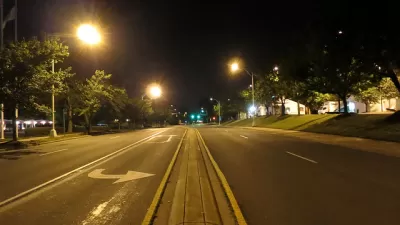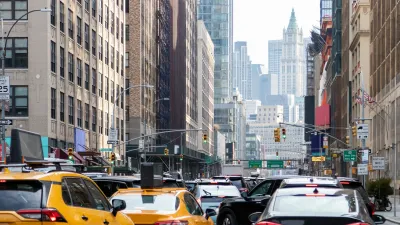Comparing wide versus narrow lanes, Kenneth A. Small and Chen Feng Ng examine the relatively unexplored design of building more compact roads to alleviate traffic congestion.
The U.S. Interstate Highway System has strict design standards that theoretically provide safe travel at high speeds, but only off-peak drivers have the opportunity to travel at high speed on these expressways. Small and Ng say, "But suppose we can design new roads, or reconfigure existing roads, to have lower speeds, neighborhood-friendly footprints, and higher capacity." For example, the standard 12-foot-wide lane is considered safe for mixed traffic at high speeds, but Small and Ng propose a road of the same total width with narrower lanes and shoulders. This would allow for more lanes to increase capacity, which means peak travelers can drive faster.
Small and Ng take a closer look at wide versus narrow lanes by comparing Expressway R of Interstate standards with Expressway C of a more compact design. They find that R has a higher free-flow speed (65.5 mph) than C (60.4 mph) under light traffic conditions, but as traffic volume increases, the decline in speed occurs more quickly on R with its fewer lanes. This was the same result when measuring average travel times. "Repeating these calculations at different traffic levels and peak-to-off-peak ratios," confirm Small and Ng, "we find the compact design performs better under all conditions in which there is appreciable queuing." The reason is that compact design depends on traffic volume, whereas regular design depends on free-flow speeds.
As for safety considerations, "it is uncertain whether the compact road design will reduce or increase safety." Wider lanes are generally regarded as safer because they provide leeway if drivers wander from their lane or swerve to avoid an accident, but there is no strong empirical evidence. "The most important factor is likely the speed chosen by drivers, which suggests a policy response," say Small and Ng. "reduce the speed limits on compact roads and add other measures to discourage speeding."
FULL STORY: When Do Slower Roads Provide Faster Travel?

Study: Maui’s Plan to Convert Vacation Rentals to Long-Term Housing Could Cause Nearly $1 Billion Economic Loss
The plan would reduce visitor accommodation by 25,% resulting in 1,900 jobs lost.

North Texas Transit Leaders Tout Benefits of TOD for Growing Region
At a summit focused on transit-oriented development, policymakers discussed how North Texas’ expanded light rail system can serve as a tool for economic growth.

Why Should We Subsidize Public Transportation?
Many public transit agencies face financial stress due to rising costs, declining fare revenue, and declining subsidies. Transit advocates must provide a strong business case for increasing public transit funding.

How to Make US Trains Faster
Changes to boarding platforms and a switch to electric trains could improve U.S. passenger rail service without the added cost of high-speed rail.

Columbia’s Revitalized ‘Loop’ Is a Hub for Local Entrepreneurs
A focus on small businesses is helping a commercial corridor in Columbia, Missouri thrive.

Invasive Insect Threatens Minnesota’s Ash Forests
The Emerald Ash Borer is a rapidly spreading invasive pest threatening Minnesota’s ash trees, and homeowners are encouraged to plant diverse replacement species, avoid moving ash firewood, and monitor for signs of infestation.
Urban Design for Planners 1: Software Tools
This six-course series explores essential urban design concepts using open source software and equips planners with the tools they need to participate fully in the urban design process.
Planning for Universal Design
Learn the tools for implementing Universal Design in planning regulations.
City of Santa Clarita
Ascent Environmental
Institute for Housing and Urban Development Studies (IHS)
City of Grandview
Harvard GSD Executive Education
Toledo-Lucas County Plan Commissions
Salt Lake City
NYU Wagner Graduate School of Public Service




























